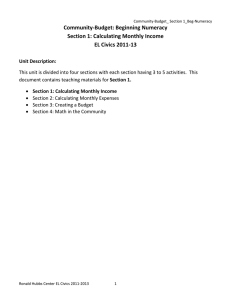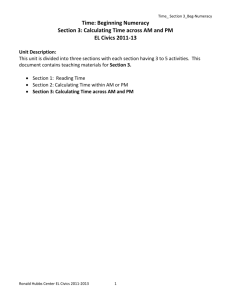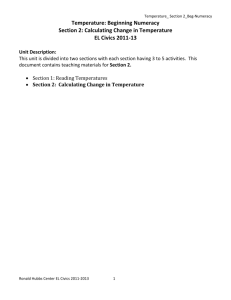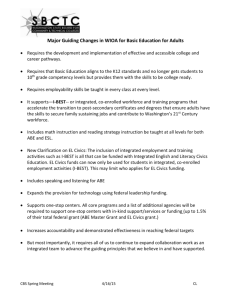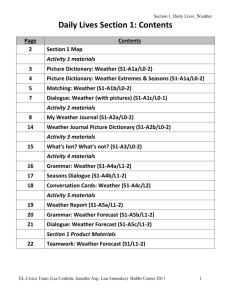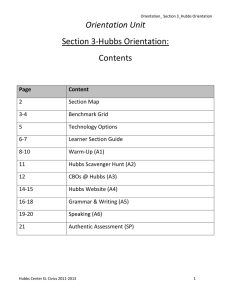Temperature - Hubbs Center
advertisement
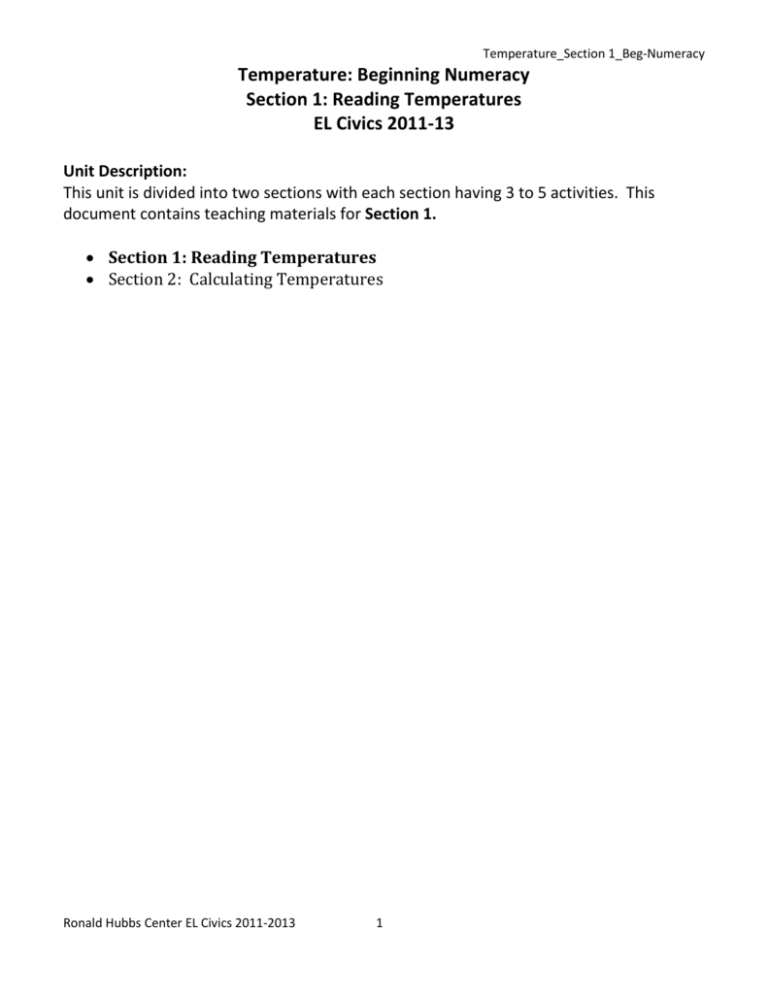
Temperature_Section 1_Beg-Numeracy Temperature: Beginning Numeracy Section 1: Reading Temperatures EL Civics 2011-13 Unit Description: This unit is divided into two sections with each section having 3 to 5 activities. This document contains teaching materials for Section 1. Section 1: Reading Temperatures Section 2: Calculating Temperatures Ronald Hubbs Center EL Civics 2011-2013 1 Temperature_Section 1_Beg-Numeracy Temperatures Discussion (S1-A1a) What is temperature? How do you know what the temperature is outside? How did you know what the temperature was in your country? What was the temperature like in your country in December? What is the temperature like here in the winter? Spring? Summer? Fall? What measurement system do you use to measure the weather in your country? What measurement system do we use here? How is temperature recorded? Why do we look at or record temperature? When and where can you see temperature readings? Discuss Celsius and Fahrenheit. Show the thermometer below and how the temperatures interrelate. What are negative temperatures? How do you read negative temperatures? What temperature is colder, 10 or -10? Why? (Ask more questions like this.) Ronald Hubbs Center EL Civics 2011-2013 2 Temperature_Section 1_Beg-Numeracy Temperature Vocabulary (S1-A1b) Teacher’s Note: Create an activity to practice the vocabulary used and generated in S1A1a). Ronald Hubbs Center EL Civics 2011-2013 3 Temperature_Section 1_Beg-Numeracy Practicing Scales for Temperature (S1-A2) Part 1: Look at the scales below. How are they different? How are they the same? 20 19 18 17 16 15 14 13 12 11 10 9 8 7 6 5 4 3 2 1 0 -1 -2 -3 -4 -5 -6 -7 -8 -9 -10 -11 -12 -13 -14 -15 -16 -17 -18 -19 -20 Scale: _________ 20 20 20 18 16 15 14 12 10 10 10 8 6 5 4 2 0 0 0 -2 -4 -5 -6 -8 -10 -10 -10 -12 -14 -15 -16 -18 -20 Scale: _________ Ronald Hubbs Center EL Civics 2011-2013 4 -20 -20 Scale: _________ Scale: _________ Temperature_Section 1_Beg-Numeracy Part 2: Write the following numbers on each of the scales below: Scale 1: 3, -5, 9, -9 20 Scale 2: 2, -7, 12, -12 Scale 3: 13, -15, 8, -19 20 20 18 16 15 14 12 10 10 10 8 6 5 4 2 0 0 0 -2 -4 -5 -6 -8 -10 -10 -10 -12 -14 -15 -16 -18 -20 -20 Ronald Hubbs Center EL Civics 2011-2013 -20 5 Temperature_Section 1_Beg-Numeracy Reading Thermometers (S1-A3) Part 1: Filling in Thermometers (www.softschools.com ) Ronald Hubbs Center EL Civics 2011-2013 6 Temperature_Section 1_Beg-Numeracy Tracking Temperatures (S1a) (Ongoing Section Product) Find the temperature for each day of class and write it on the thermometer. You will graph these temperatures later. Day 1: Day 2: Ronald Hubbs Center EL Civics 2011-2013 Day 3: 7 Day 4: Day 5: Temperature_Section 1_Beg-Numeracy Temperature Line Graph Template (S1b) Part 1: Use the daily temperatures you wrote on your thermometers to create a line graph below. 1. Title your graph 2. Choose a scale and write that scale on the left 3. Write the days of the week below the graph, under each column. Use abbreviations (M, T, W, etc.) 4. Put one data point for each temperature for each day of the week 5. Connect the data points to finish the line graph Title: _______________________ Part 2: Write 3 questions about the information on this graph. Use words like change in temperature, final temperature, increase, decrease, rise, rose, fall, fell, drop, and dropped. 1. 2. 3. Ronald Hubbs Center EL Civics 2011-2013 8 Temperature_Section 1_Beg-Numeracy Analyzing Temperature Line Graph Activity (S1c) Teacher Instructions Using the line graph created in Section 1, create questions that allow students to compare the temperatures. This will make a great transition into Section 2. For example: Which day had a higher temperature, Monday or Tuesday? Which day had the highest temperature? Which day had a lower temperature, Wednesday or Thursday? Which day had the lowest temperature? What is the change in temperature between Monday and Tuesday? Did the temperature increase or decrease from Tuesday to Wednesday? If the temperature on Tuesday increased 10°, what would the final temperature be? After asking students a number of these questions, have students create their own questions to ask about the line graph. Ronald Hubbs Center EL Civics 2011-2013 9
